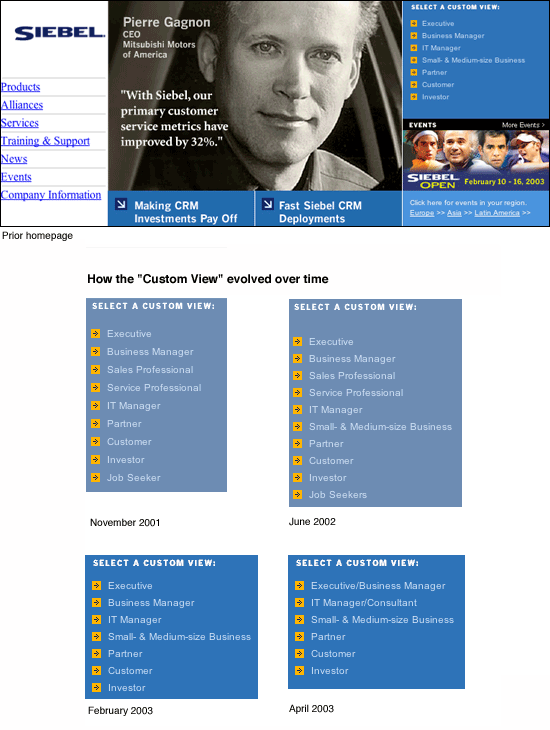June 05, 2004
Off to Europe...
So posts will be *even sparser* than normal. Apologies ahead of time if I let comment spam sit too long.
June 02, 2004
Thinking About Audience Segmentation
While this is not an explicit Explicit Design volley, it's definitely related.
A holy grail in Web site information architecture is the ability to cleanly segment content by audience type. Much of the content on a website is not applicable to every single person, but without good segmenting methods, we have to expose all that content to everyone.
Some sites have it easy. An Adaptive Path favorite is Hay Net.

However, few folks have such easily separated audiences. This is particularly true in high-tech marketing, an area I've been deeply involved in ever since working with PeopleSoft in 2001. Every high-tech marketer wants to target different messages at different levels within the potential customer's organization -- executives get a Business Value message, directors and managers get an Ease of Integration message; developers get technical specifications, etc.
One company actually went pretty hard to market with these distinctions: Siebel. Thanks to the Wayback machine, I was able to dredge up their "custom views" over the last few years.

Well, I went to Siebel.com today, and noticed that they've dropped Custom Views. If you ever clicked around their Custom Views, you know that they never really did the concept service -- there'd be a single page for each audience, but beyond that, the distinction was lost.
But I don't think the real problem was execution. I think it was more fundamental. It's pretty much impossible making good clean distinctions that visitors can select themselves by. The changes in Siebel's options show this. In June 2002 they add "Small and Medium Business", in part reflecting the importance of the market, but also because an "executive" of a small business has a lot more in common with a "business manager" of a large corporation.
I find the combination, in April 2003, of "executive" and "business manager" telling. It's basically them throwing in the towel for this kind of audience segmentation. What's happening here is that Siebel is realizing that meaningful segmentation doesn't have as much to do with job titles and self-identification, as it does with the types of tasks the people are engaged in. When it comes to enterprise software, Executives and Business Managers start to blur -- you pretty much just want the best value for the money.
And this is why Siebel was wise to ditch the Custom Views altogether. It was an attempt on their part to be Explicit -- what could be more explicit than getting people to *exactly* the content best suited to their needs -- but it ran against the reality that, when it comes to marketing products, "audience type" is the wrong type of explicit. All that matters to the visitor is their task at hand, not what some company thinks of their job title, and they'll click immediately to whatever they believe will support that task -- which is likely one of the clearly labeled main navigation areas.
All this said, I don't advocate never segmenting by audiences. But you can only successfully do so when the audience accepts the labels as meaningfully applying to themselves. One realm where this works is higher education. UCLA's home page clearly distinguishes its audiences.

The reason this works is that the *tasks* -- what people want to do at UCLA's site -- cleanly break down by audience types. Future students have interests distinct from current students. Current students distinct from faculty. Etc. Not to say they're mutually exclusive -- but a visitor can look at those selections and click with assurance. You can't do that with a selection like "business manager."
Anyway, I feel this really resonates with the notions of Explicit Design. If you can be explicit and meaningful -- such as Hay Net, or UCLA -- then by all means you should. But if you can't be explicit, as in segmenting potential customer audience types for high tech, then attempts at being so will backfire, because this faux explicitness confuses the visitor when they don't see an option that inspires confident selection.
Paying attention to Mind Wide Open
I'm reading Steven Johnson's Mind Wide Open, and just completed Chapter 3, "Your Attention Please." In it, he discusses the many facets of attention, and I found myself having trouble keeping them all squared away. It made me wonder why there wasn't a diagram of some sort to help express the relation between these various elements.
So I drew a diagram, if only to help me keep it together.

After drawing the diagram, I realized why there might not have been one in the book. Making a clear sketch wasn't easy. Oh well.
May 31, 2004
Heading to Europe - June 7th - June 23rd
Hey all. As my newly updated travel map depicts (Flash required), I'm off to Europe. Itinerary:
7 - 11 June: Amsterdam
11 - 14 June: Paris
14 - 17 June: Languedoc, France (Cathar castles, etc.)
17 - 20 June: Barcelona
20 - 24 June: Amsterdam
This trip is bookended by work-related gigs. I'm speaking at Sigchi.nl's annual conference on 10 June, and with Jeffrey Veen, I'm teaching Beyond Usability on 22-23 June.
I'm posting this, in part, because I'd love to touch base with peterme readers on my travels. If I'll be where you are, and you'd like to hang out, email me.

